Christoph Kerzig
@ckerzig.bsky.social
Photochemist, former Leopoldina Postdoc, Husband, Father of 2, Chemistry Professor @ JGU Mainz, board member of the GDCh photochem. section https://www.ak-kerzig.chemie.uni-mainz.de/
The symposium will start in about 2 hours. Don't miss the opportunity to hear five short talks dealing with diverse topics in the #photochemistry field, followed by a plenary lecture. 👇
The first online symposium organized by the @gdch.de Division of Photochemistry will take place next week (Nov. 5, 2025, 3 pm CET zone).
tu-braunschweig.webex.com/tu-braunschw...
key: Photo2025
5 talks by talented students (one will be awarded🎉) followed by a plenary lecture. Save the date. ✍️
tu-braunschweig.webex.com/tu-braunschw...
key: Photo2025
5 talks by talented students (one will be awarded🎉) followed by a plenary lecture. Save the date. ✍️
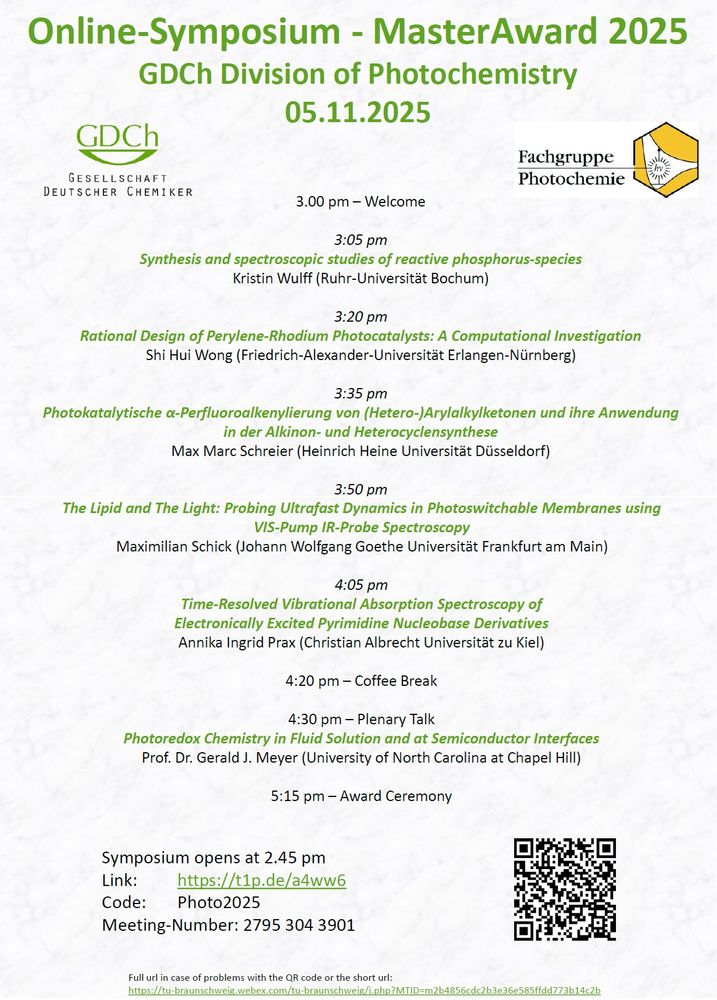
November 5, 2025 at 11:42 AM
The symposium will start in about 2 hours. Don't miss the opportunity to hear five short talks dealing with diverse topics in the #photochemistry field, followed by a plenary lecture. 👇
On my way to Basel to attend the Dreyfus Lectureship, which will be given by Jim McCusker. Sun is shining and the train is almost on time. #MondayMorning
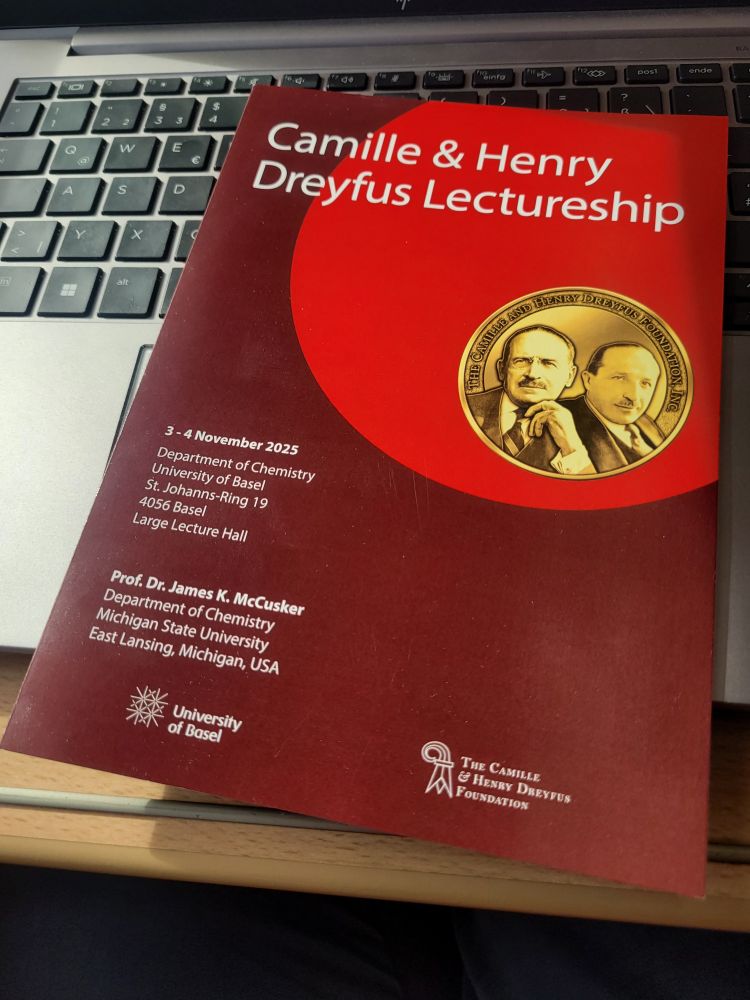
November 3, 2025 at 9:46 AM
On my way to Basel to attend the Dreyfus Lectureship, which will be given by Jim McCusker. Sun is shining and the train is almost on time. #MondayMorning
The first online symposium organized by the @gdch.de Division of Photochemistry will take place next week (Nov. 5, 2025, 3 pm CET zone).
tu-braunschweig.webex.com/tu-braunschw...
key: Photo2025
5 talks by talented students (one will be awarded🎉) followed by a plenary lecture. Save the date. ✍️
tu-braunschweig.webex.com/tu-braunschw...
key: Photo2025
5 talks by talented students (one will be awarded🎉) followed by a plenary lecture. Save the date. ✍️

October 28, 2025 at 7:57 AM
The first online symposium organized by the @gdch.de Division of Photochemistry will take place next week (Nov. 5, 2025, 3 pm CET zone).
tu-braunschweig.webex.com/tu-braunschw...
key: Photo2025
5 talks by talented students (one will be awarded🎉) followed by a plenary lecture. Save the date. ✍️
tu-braunschweig.webex.com/tu-braunschw...
key: Photo2025
5 talks by talented students (one will be awarded🎉) followed by a plenary lecture. Save the date. ✍️
Nice piece of work Kasper & team. I guess we should update this sentence in our current preprint: "While the influence of TIPS-ethynyl groups was not investigated with the frequently-studied perylene annihilator chromophore, ..."😅
Excited to share the publication of “Enhancing the Statistical Probability Factor in Triplet-Triplet Annihilation Photon Upconversion via TIPS Functionalization” in @chemicalscience.rsc.org
pubs.rsc.org/en/content/a...
pubs.rsc.org/en/content/a...

October 7, 2025 at 9:01 PM
Nice piece of work Kasper & team. I guess we should update this sentence in our current preprint: "While the influence of TIPS-ethynyl groups was not investigated with the frequently-studied perylene annihilator chromophore, ..."😅
Till defended his PhD thesis today.🍾 Extremely convincing discussion and great performance resulted in degree with highest distinction💪. All the best for your postdoc in Bologna, where Giacomo Ciamician did pioneering work in #photochemistry. Curious to see what Till will achieve 🤔

September 30, 2025 at 6:42 PM
Till defended his PhD thesis today.🍾 Extremely convincing discussion and great performance resulted in degree with highest distinction💪. All the best for your postdoc in Bologna, where Giacomo Ciamician did pioneering work in #photochemistry. Curious to see what Till will achieve 🤔
Julian's manuscript dealing with a novel biphenyl annihilator and unusual effects of different substituents. Is it a new benchmark system for blue-to-UV upconversion? Read about it here: chemrxiv.org/engage/chemr...
Many thanks to our collaboration partner @nobuhiroyanai.bsky.social and Masanori.
Many thanks to our collaboration partner @nobuhiroyanai.bsky.social and Masanori.

September 12, 2025 at 11:51 AM
Julian's manuscript dealing with a novel biphenyl annihilator and unusual effects of different substituents. Is it a new benchmark system for blue-to-UV upconversion? Read about it here: chemrxiv.org/engage/chemr...
Many thanks to our collaboration partner @nobuhiroyanai.bsky.social and Masanori.
Many thanks to our collaboration partner @nobuhiroyanai.bsky.social and Masanori.
Reposted by Christoph Kerzig
Researchers at Johannes Gutenberg University Mainz report a manganese complex that stays energized for 190 ns after absorbing light—a record for low-cost abundant metals. cen.acs.org/materials/in... #chemsky 🧪

Manganese edges into the realm of noble-metal photochemistry
Pairing manganese with an off-the-shelf ligand yields a low-cost complex that mimics precious-metal photocatalysts
cen.acs.org
September 10, 2025 at 3:17 PM
Researchers at Johannes Gutenberg University Mainz report a manganese complex that stays energized for 190 ns after absorbing light—a record for low-cost abundant metals. cen.acs.org/materials/in... #chemsky 🧪
Reposted by Christoph Kerzig
New molecular design absorbs 2 photons to store 2 positive and 2 negative charges
100 ns lifetime, 3 eV energy storage, and 37% quantum yield
A step toward multi-electron photochemistry
Mathis Brändlin and @bjoernpfund.bsky.social in @natchem.nature.com
www.nature.com/articles/s41...
100 ns lifetime, 3 eV energy storage, and 37% quantum yield
A step toward multi-electron photochemistry
Mathis Brändlin and @bjoernpfund.bsky.social in @natchem.nature.com
www.nature.com/articles/s41...

Photoinduced double charge accumulation in a molecular compound - Nature Chemistry
The photoinduced accumulation of redox equivalents is a challenging requirement for artificial photosynthesis. Now a molecule has been developed in which the sequential absorption of photons results i...
www.nature.com
August 27, 2025 at 8:14 AM
New molecular design absorbs 2 photons to store 2 positive and 2 negative charges
100 ns lifetime, 3 eV energy storage, and 37% quantum yield
A step toward multi-electron photochemistry
Mathis Brändlin and @bjoernpfund.bsky.social in @natchem.nature.com
www.nature.com/articles/s41...
100 ns lifetime, 3 eV energy storage, and 37% quantum yield
A step toward multi-electron photochemistry
Mathis Brändlin and @bjoernpfund.bsky.social in @natchem.nature.com
www.nature.com/articles/s41...
Reposted by Christoph Kerzig
We show how photoredox catalysis can bypass Kasha’s rule, enabling reactions from higher excited states.
This work, led by the exceptional @bjoernpfund.bsky.social, offers new insights into photochemical reactivity.
Published in JACS @jacs.acspublications.org
bit.ly/3IysmjX
This work, led by the exceptional @bjoernpfund.bsky.social, offers new insights into photochemical reactivity.
Published in JACS @jacs.acspublications.org
bit.ly/3IysmjX

Breaking Kasha’s Rule to Enable Higher Reactivity in Photoredox Catalysis
Nearly all photochemical transformations known to date follow Kasha’s rule, implying that reactions occur only from the lowest electronically excited state of a given spin multiplicity due to the fast...
bit.ly
July 18, 2025 at 7:00 AM
We show how photoredox catalysis can bypass Kasha’s rule, enabling reactions from higher excited states.
This work, led by the exceptional @bjoernpfund.bsky.social, offers new insights into photochemical reactivity.
Published in JACS @jacs.acspublications.org
bit.ly/3IysmjX
This work, led by the exceptional @bjoernpfund.bsky.social, offers new insights into photochemical reactivity.
Published in JACS @jacs.acspublications.org
bit.ly/3IysmjX
The next masterpiece from Matthias focusing on Coulombic dyads as new #photocatalyst class has been accepted in ACIE. Higher quantum yields in red-light catalysis by adding an inexpensive salt to use #Os as efficiently as possible. onlinelibrary.wiley.com/doi/10.1002/... @labheinze.bsky.social

June 24, 2025 at 6:41 PM
The next masterpiece from Matthias focusing on Coulombic dyads as new #photocatalyst class has been accepted in ACIE. Higher quantum yields in red-light catalysis by adding an inexpensive salt to use #Os as efficiently as possible. onlinelibrary.wiley.com/doi/10.1002/... @labheinze.bsky.social
Two weeks left for completing the registration for the Molecules and Light 2025 conference in beautiful Poznań. Also abstract submission is still possible.
molecules_light2025.web.amu.edu.pl
molecules_light2025.web.amu.edu.pl
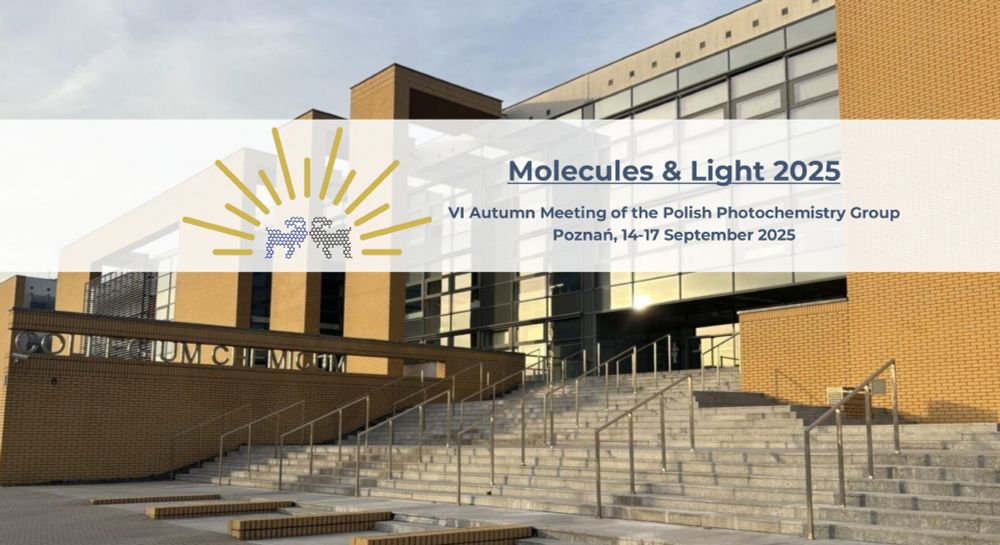
June 16, 2025 at 11:28 AM
Two weeks left for completing the registration for the Molecules and Light 2025 conference in beautiful Poznań. Also abstract submission is still possible.
molecules_light2025.web.amu.edu.pl
molecules_light2025.web.amu.edu.pl
Reposted by Christoph Kerzig
New Hot article from @ckerzig.bsky.social, @gloriusfrank.bsky.social and colleagues:
'Pushing the limit of triplet–triplet annihilation photon upconversion towards the UVC range' 🔥
#OpenAccess 🔓
'Pushing the limit of triplet–triplet annihilation photon upconversion towards the UVC range' 🔥
#OpenAccess 🔓

Pushing the limit of triplet–triplet annihilation photon upconversion towards the UVC range
Triplet–triplet annihilation photon upconversion (TTA-UC) provides a milder alternative to traditional UVB/UVC photochemistry. However, suitable sensitizer-annihilator pairs are scarce, in particular…
buff.ly
June 4, 2025 at 12:02 PM
New Hot article from @ckerzig.bsky.social, @gloriusfrank.bsky.social and colleagues:
'Pushing the limit of triplet–triplet annihilation photon upconversion towards the UVC range' 🔥
#OpenAccess 🔓
'Pushing the limit of triplet–triplet annihilation photon upconversion towards the UVC range' 🔥
#OpenAccess 🔓
One photon or two photons, that is the question. We discuss mechanistic challenges, pitfalls, and opportunities for future research in two-photon photocatalysis @angewandtechemie.bsky.social. Many thanks to first-authors Julian and Sophie.
onlinelibrary.wiley.com/doi/10.1002/...
onlinelibrary.wiley.com/doi/10.1002/...
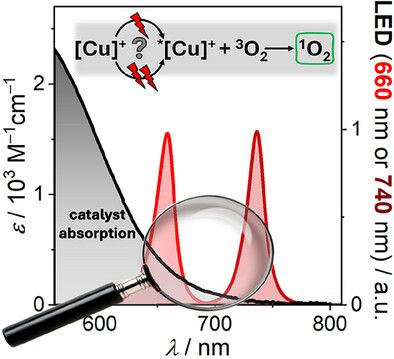
June 2, 2025 at 7:02 AM
One photon or two photons, that is the question. We discuss mechanistic challenges, pitfalls, and opportunities for future research in two-photon photocatalysis @angewandtechemie.bsky.social. Many thanks to first-authors Julian and Sophie.
onlinelibrary.wiley.com/doi/10.1002/...
onlinelibrary.wiley.com/doi/10.1002/...
The last paper of Till's PhD has finally been accepted and is online in JACS Au
pubs.acs.org/doi/10.1021/...
Insights into energy transfer in DNA through a fruitful collaboration with the Wagenknecht lab.
pubs.acs.org/doi/10.1021/...
Insights into energy transfer in DNA through a fruitful collaboration with the Wagenknecht lab.
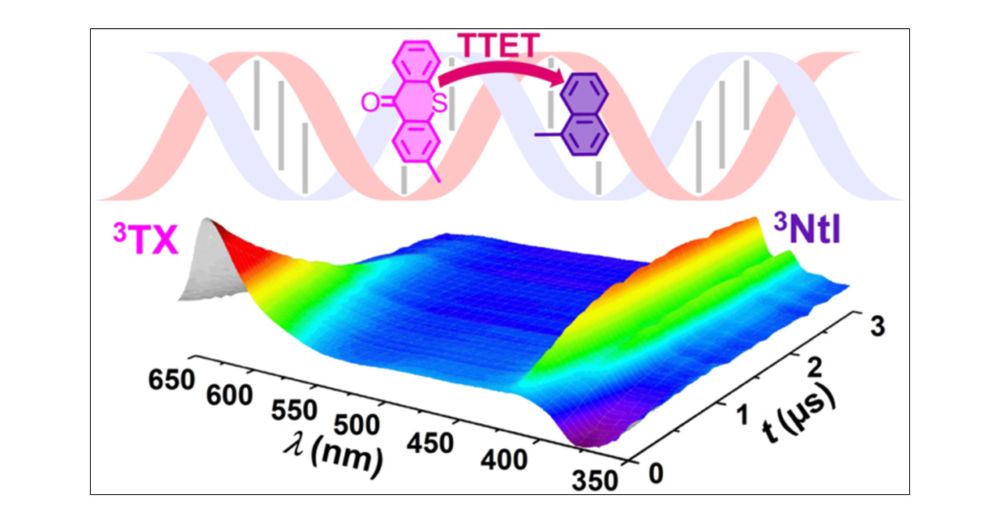
Direct Observation of Triplet–Triplet Energy Transfer in DNA between Energy Donor and Acceptor C-Nucleotides
Investigating the migration of excited-state energy in DNA is crucial for a deep understanding of protection mechanisms and light-induced DNA damage. While numerous reports focused on single electron transfer and Förster-type energy transfer in DNA, studies on the Dexter-type triplet–triplet energy transfer are scarce, in particular, those with direct detection of photoexcited triplet states. Herein, we present direct measurements of the distance-dependent triplet–triplet energy transfer rates through DNA by using transient absorption spectroscopy. This was achieved through the synthetic incorporation of thioxanthone as an energy donor and naphthalene as an energy acceptor into a DNA double strand at defined positions. The energy transfer rates strongly depend on the number of A-T base pairs (up to four) separating the energy donor from the energy acceptor. We observed a fast energy transfer rate with a time constant of 17 ns for the DNA sample in which the donor and acceptor are directly adjacent in the DNA. By analyzing two additional donor–acceptor distances, a steep exponential distance dependence with an attenuation factor of 1.15 Å–1 could be obtained. Our results demonstrate that DNA acts as a poor conductor of triplet energy when energy donors with triplet energies below 2.7 eV are used, complementing more indirect studies on sensitized DNA damage.
pubs.acs.org
May 28, 2025 at 6:46 AM
The last paper of Till's PhD has finally been accepted and is online in JACS Au
pubs.acs.org/doi/10.1021/...
Insights into energy transfer in DNA through a fruitful collaboration with the Wagenknecht lab.
pubs.acs.org/doi/10.1021/...
Insights into energy transfer in DNA through a fruitful collaboration with the Wagenknecht lab.
Reposted by Christoph Kerzig
Sie sind Vorbilder für Nachwuchswissenschaftler:innen und prägen durch ihren herausragenden Einsatz in Forschung & Entwicklung den Innovationsstandort 🇩🇪 entscheidend mit: unsere Dozentenpreisträger:innen Corina Andronescu, @ckerzig.bsky.social & Golo Storch! www.vci.de/fonds/preise...
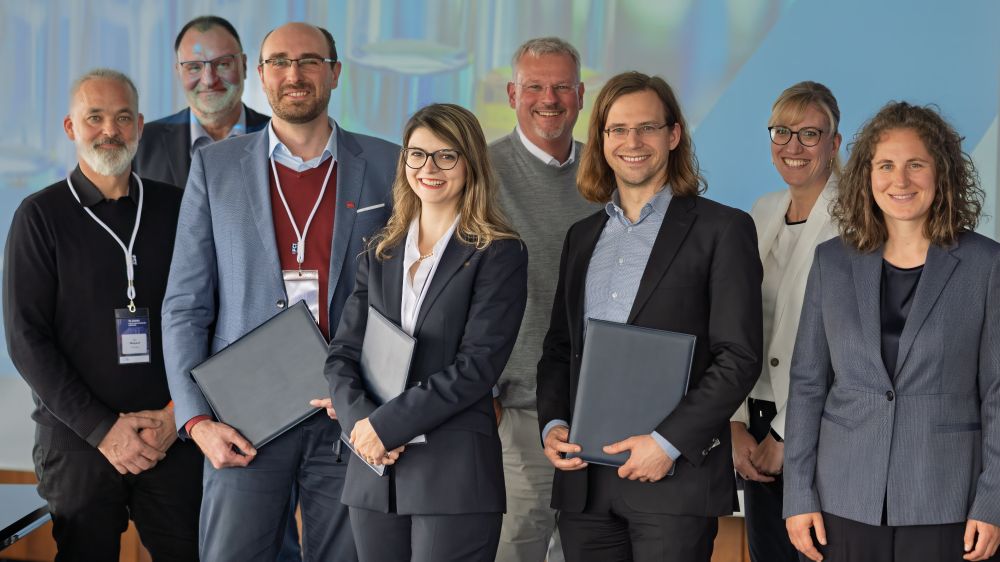

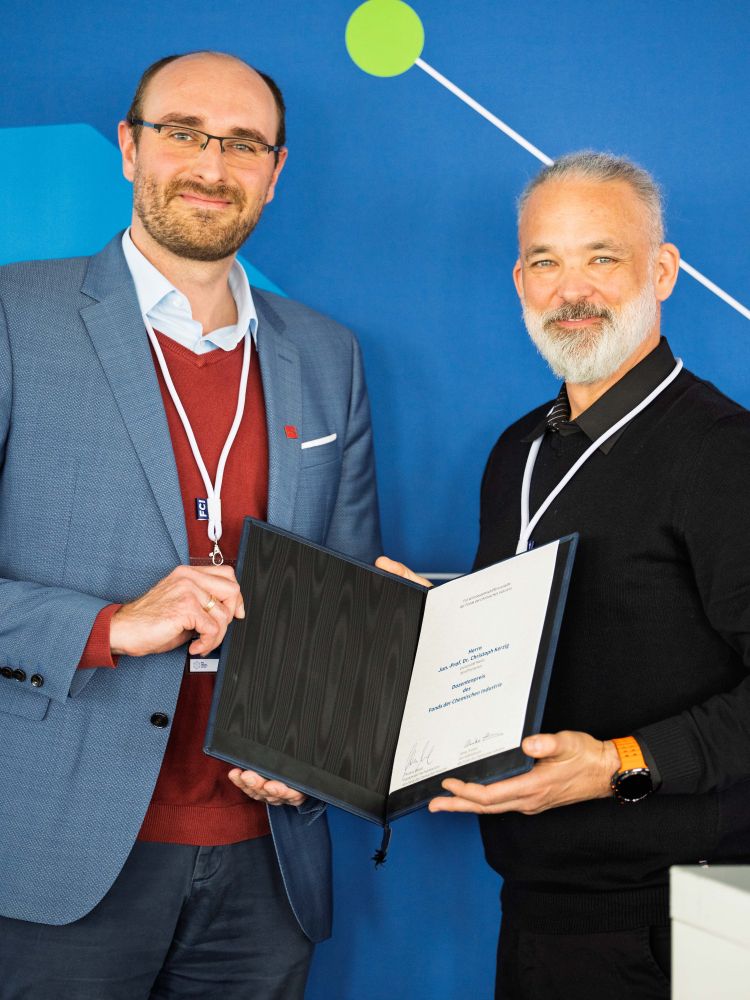
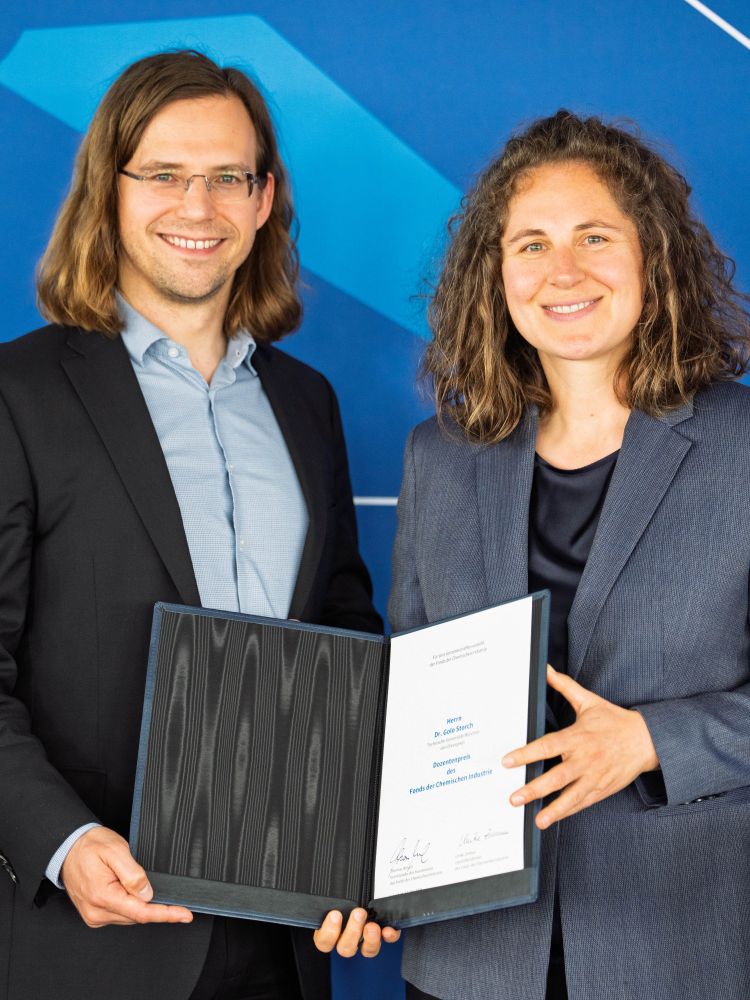
May 26, 2025 at 7:16 AM
Sie sind Vorbilder für Nachwuchswissenschaftler:innen und prägen durch ihren herausragenden Einsatz in Forschung & Entwicklung den Innovationsstandort 🇩🇪 entscheidend mit: unsere Dozentenpreisträger:innen Corina Andronescu, @ckerzig.bsky.social & Golo Storch! www.vci.de/fonds/preise...
It was our pleasure. We really enjoyed working with the user-friendly instrument. Many thanks for developing the HARPIA-LIGHT system. Here is the link to the first paper containing measurements carried out with it: pubs.acs.org/doi/10.1021/...
May 14, 2025 at 6:37 PM
It was our pleasure. We really enjoyed working with the user-friendly instrument. Many thanks for developing the HARPIA-LIGHT system. Here is the link to the first paper containing measurements carried out with it: pubs.acs.org/doi/10.1021/...
Reposted by Christoph Kerzig
Can you #recyle your molecular #photocatalyst? Can you use #water in your #photocatalysis? Can you use #sunlight? Can undergrads prepare the photocatalyst on >12 g scale? Out now in Advanced Synthesis and Catalysis lmy.de/BgahY. Thanks to @dfg.de for funding.

April 10, 2025 at 7:49 PM
Can you #recyle your molecular #photocatalyst? Can you use #water in your #photocatalysis? Can you use #sunlight? Can undergrads prepare the photocatalyst on >12 g scale? Out now in Advanced Synthesis and Catalysis lmy.de/BgahY. Thanks to @dfg.de for funding.
Many thanks for your kind words. Highly appreciated!
It was also great to interact with you during the coffee break.
It was also great to interact with you during the coffee break.
Major congratulations to Christoph Kerzig @ckerzig.bsky.social for being awarded the prestigious Carl Duisburg Memorial Prize at the #Chemiedozententagung #CDT2025.
Looking forward to an outstanding lecture on his achievements in
photochemical energy conversion and #photocatalysis.
Looking forward to an outstanding lecture on his achievements in
photochemical energy conversion and #photocatalysis.

March 18, 2025 at 11:14 AM
Many thanks for your kind words. Highly appreciated!
It was also great to interact with you during the coffee break.
It was also great to interact with you during the coffee break.
Our collaborative manuscript with the Wagenknecht lab (KIT) is finally online. Dexter energy transfer in DNA and its distance dependence has been observed using TA spectroscopy. #triplet #photochemistry

March 7, 2025 at 1:45 PM
Our collaborative manuscript with the Wagenknecht lab (KIT) is finally online. Dexter energy transfer in DNA and its distance dependence has been observed using TA spectroscopy. #triplet #photochemistry
Our very own Matthias after presenting his results on Coulombic dyads. pubs.acs.org/doi/10.1021/...
#proudPI #photochemistry
#proudPI #photochemistry
March 6, 2025 at 7:38 PM
Our very own Matthias after presenting his results on Coulombic dyads. pubs.acs.org/doi/10.1021/...
#proudPI #photochemistry
#proudPI #photochemistry
Reposted by Christoph Kerzig
One month to go to the abstract submission deadline (24/03/25) for contributed talks at the 5th International #SolarFuels conference, which we're organising together with the @rsc.org in Newcastle, UK, this September.
#chemsky #photocatalysis
#chemsky #photocatalysis
Oral abstract submission is open for the 5th International #SolarFuels conference, which we're organising this September in the UK together with the @roysocchem.bsky.social.
Abstract submission and more details please see: t.co/SC9X9sLpBX. Abstract deadline: 24/03/25.
#chemsky #photocatalysis
Abstract submission and more details please see: t.co/SC9X9sLpBX. Abstract deadline: 24/03/25.
#chemsky #photocatalysis

February 24, 2025 at 4:25 PM
One month to go to the abstract submission deadline (24/03/25) for contributed talks at the 5th International #SolarFuels conference, which we're organising together with the @rsc.org in Newcastle, UK, this September.
#chemsky #photocatalysis
#chemsky #photocatalysis
I feel deeply honored. Many thanks to my young team of highly motivated scientist, my mentors and the selection committee🙏🍾
Auf der Chemiedozententagung (CDT) 2025 verleiht die GDCh Karl Arnold Reuter, Freiburg, die Carl-Duisberg-Plakette und Christoph Kerzig, Johannes Gutenberg-Universität Mainz, den Carl-Duisberg-Gedächtnispreis. Zudem erhalten drei junge Wissenschaftler:innen ADUC-Preise: gdch.app/article/gdch...

GDCh vergibt Carl-Duisberg-Plakette und Carl-Duisberg-Gedächtnispreis
Rund 350 Chemikerinnen und Chemiker kommen vom 17. bis zum 19. März an der Technischen Universität Braunschweig zur Chemiedozententagung (CDT) 2025 zusammen. Auf der Veranstaltung verleiht die Gesells...
gdch.app
February 20, 2025 at 2:51 PM
I feel deeply honored. Many thanks to my young team of highly motivated scientist, my mentors and the selection committee🙏🍾
Reposted by Christoph Kerzig
Registration for the 32nd International Conference on Photochemistry is now open! Secure your spot at #ICP2025 and join us in Aachen for an exciting week of cutting-edge photochemistry.
Register now at 👉 www.icp2025.de
Register now at 👉 www.icp2025.de

ICP2025
The 32nd International Conference on Photochemistry will take place from July 13 (Sunday) to July 18 (Friday), 2025 in Aachen (Germany). The event is jointly organized by the RWTH Aachen University…
www.icp2025.de
February 14, 2025 at 8:06 AM
Registration for the 32nd International Conference on Photochemistry is now open! Secure your spot at #ICP2025 and join us in Aachen for an exciting week of cutting-edge photochemistry.
Register now at 👉 www.icp2025.de
Register now at 👉 www.icp2025.de
Many thanks to @hadlingtongroup.bsky.social @joshabbenseth.bsky.social Gabriele Hierlmeier and Frank Tambornino for highlighting our Coulombic dyad approach as a new trend.
onlinelibrary.wiley.com/doi/10.1002/...
onlinelibrary.wiley.com/doi/10.1002/...
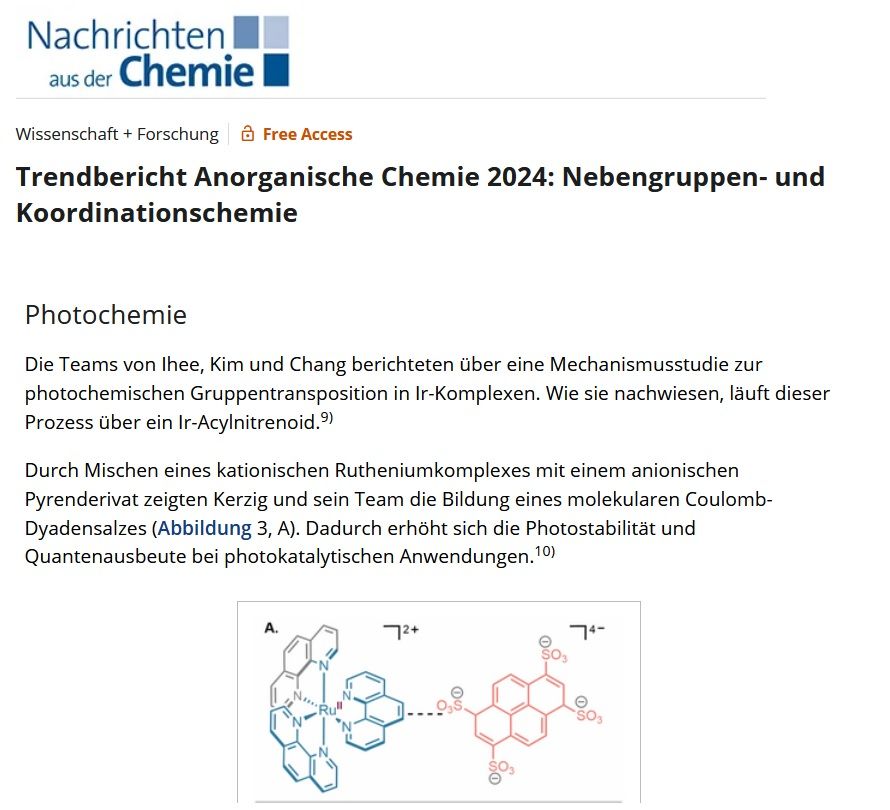
February 2, 2025 at 10:39 AM
Many thanks to @hadlingtongroup.bsky.social @joshabbenseth.bsky.social Gabriele Hierlmeier and Frank Tambornino for highlighting our Coulombic dyad approach as a new trend.
onlinelibrary.wiley.com/doi/10.1002/...
onlinelibrary.wiley.com/doi/10.1002/...
A must-read in the photoredox community. Great to see this from my former MSc student Björn in the @WengerOliver lab. Time flies.
Excited organic radicals in photoredox catalysis
Our perspective just published in JACS Au:
pubs.acs.org/doi/10.1021/...
Our perspective just published in JACS Au:
pubs.acs.org/doi/10.1021/...

Excited Organic Radicals in Photoredox Catalysis
Many important synthetic-oriented works have proposed excited organic radicals as photoactive species, yet mechanistic studies raised doubts about whether they can truly function as photocatalysts. This skepticism originates from the formation of (photo)redox-active degradation products and the picosecond decay of electronically excited radicals, which is considered too short for diffusion-based photoinduced electron transfer reactions. From this perspective, we analyze important synthetic transformations where organic radicals have been proposed as photocatalysts, comparing their theoretical maximum excited state potentials with the potentials required for the observed photocatalytic reactivity. We summarize mechanistic studies of structurally similar photocatalysts indicating different reaction pathways for some catalytic systems, addressing cases where the proposed radical photocatalysts exceed their theoretical maximum reactivity. Additionally, we perform a kinetic analysis to explain the photoinduced electron transfer observed in excited radicals on subpicosecond time scales. We further rationalize the potential anti-Kasha reactivity from higher excited states with femtosecond lifetimes, highlighting how future photocatalysis advancements could unlock new photochemical pathways.
pubs.acs.org
January 29, 2025 at 8:40 PM
A must-read in the photoredox community. Great to see this from my former MSc student Björn in the @WengerOliver lab. Time flies.

